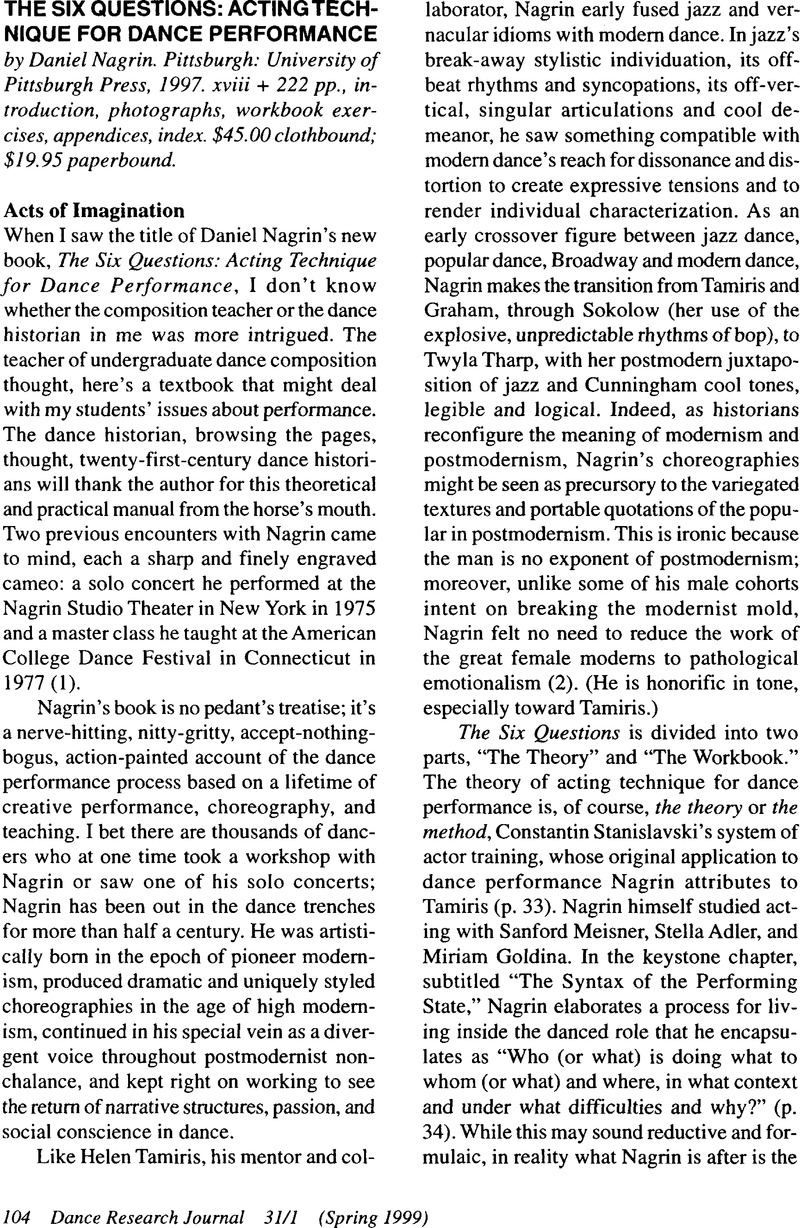No CrossRef data available.
Article contents
The Six Questions: Acting Technique for Dance Performance, by Daniel Nagrin. Pittsburgh: University of Pittsburgh Press, 1997. xviii + 222 pp., introduction, photographs, workbook exercises, appendices, index. $45.00 clothbound; $19.95 paperbound.
Published online by Cambridge University Press: 22 July 2014
Abstract

- Type
- Reviews
- Information
- Copyright
- Copyright © Congress on Research in Dance 1999
References
NOTES
1. The concert was probably Jazz Changes (14 March 1975). See Schlundt, Christena L., Daniel Nagrin: A Chronicle of His Professional Career (Berkeley: University of California Press, 1997), p. 139.Google Scholar
2. See, for example, Hawkins, Erick, “Pure Poetry,” The Modern Dance: Seven Statements of Belief, ed. Cohen, Selma Jeanne (Middletown, CT: Wesleyan University Press, 1966), p. 44 Google Scholar; also, Nikolais, Alwin, “Excerpts from ‘Nik: A Documentary,’” The Vision of Modern Dance, ed. Brown, Jean Morrison (Pennington, NJ: Princeton Book Company, 1979), p. 113.Google Scholar
3. Nagrin is not the first to write about the implications of Stanislavski's theories for dance practice. In 1972 the American Dance Guild (New York) published a monograph by Valentina Litvinoff entitled The Use of Stanislavsky within Modern Dance. However, Litvinoff's work is a theoretical/ aesthetic analysis oriented toward teachers and scholars, while Nagrin's book is a documentation of theory-into-practice oriented toward students or developing artists (though teachers will find it equally informative).
4. See Strunk, William Jr., and White, E. B., The Elements of Style, 3rd ed. (Boston: Allyn and Bacon, 1979), p. 21 Google Scholar: “Prefer the specific to the general, the definite to the vague, the concrete to the abstract.”
5. Marcus and Cushman, quoted in Maanen, John Van, Tales of the Field: On Writing Ethnography (Chicago: University of Chicago Press, 1988), p. 49.Google Scholar
6. See chapter 2, “Developing Creativity” in Hawkins, Alma M., Creating through Dance, rev. ed. (Pennington, NJ: Princeton Book Company, 1988), pp. 11–30.Google Scholar
7. Compare Grotowski, Jerzy, “Skara Speech” and “Statement of Principles,” Towards a Poor Theatre (New York: Simon and Schuster, 1968), pp. 225–242 and 255–262Google Scholar; also, Blumenthal, Eileen, Joseph Chaikin, Directors in Perspective series (New York: Cambridge University Press, 1984), especially “An Open Theory,” pp. 38–66.Google Scholar
8. See in particular chapter 10, “The Actors Studio” in Warren, Larry, Anna Sokolow: The Rebellious Spirit (Pennington, NJ: Princeton Book Company, 1991), pp. 115–122.Google Scholar
9. Chuan, Chieh Tzu Hua, The Mustard Seed Garden Manual of Painting, quoted in Nagrin, p. 68.Google Scholar
10. Goleman, Daniel P., Emotional Intelligence, reprint ed. (New York: Bantam, 1997).Google Scholar


